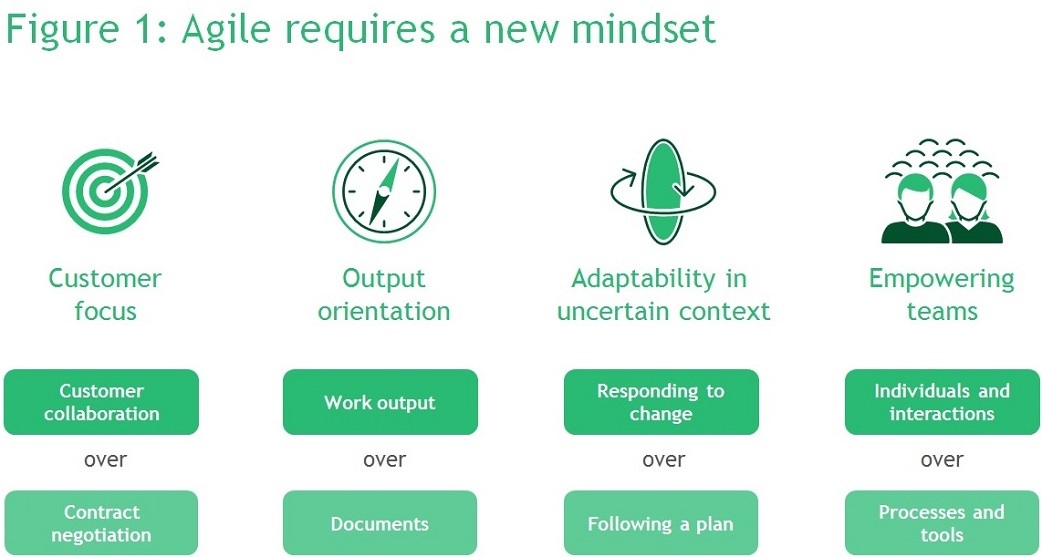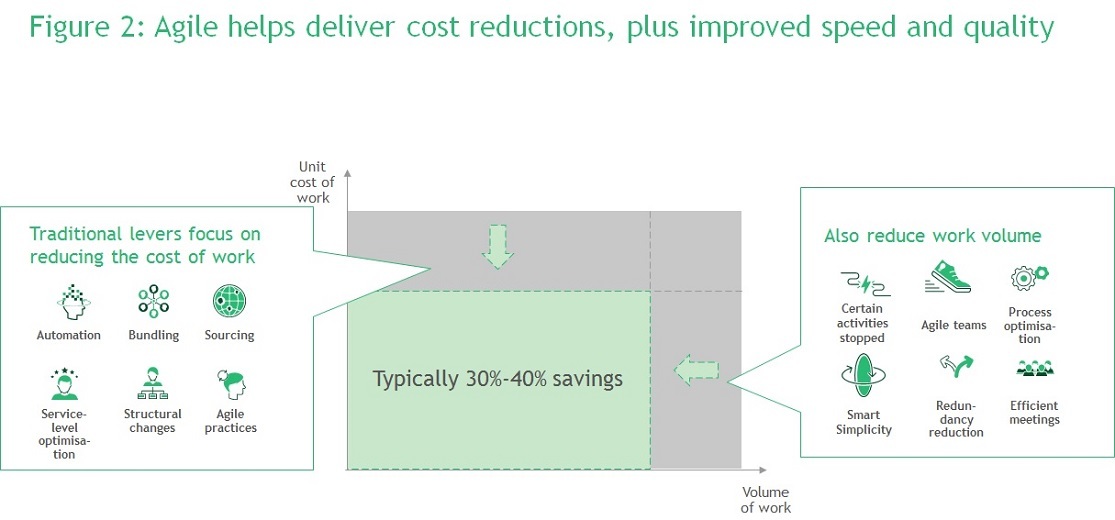But changing how work is done isn't easy.
It requires unfamiliar ways of thinking as well as the willingness and ability to foster new levels of collaboration, openness and creativity (see figure 1, below). Ultimately, all this calls for a different mindset. While agile practices have long proven their mettle in industries such as software engineering, mining companies (and industrial companies in general) have had a particularly difficult time adopting them.
This difficulty stems in part from the organisational culture currently characterising many industrial businesses. For instance, mine planning unfolds over a slow-moving, long-term cycle, with investment decisions sometimes taking 8-10 years from inception to execution. Accustomed to this pacing, many miners are understandably slow to embrace large-scale transformation efforts requiring speedy execution.
What's more, they typically look to industry peers—not companies in other industries—for inspiration on how best to boost their performance and solve their most pressing business problems. They therefore miss out on the insights that agile players in other industries have gained through first-hand experience.

Additionally, many miners find it challenging to incorporate key tenets of their operating model—namely capital discipline and workforce safety—into agile ways of working. For example, they (rightly) may hesitate to strive for accelerated decision-making if they think that doing so represents lack of discipline, and could therefore lead to misdirection of capital or injury to employees.
Finally, some miners have tried their hand at implementing agile trials. But they haven't backed these efforts with the required change in mindset and sufficient support and resources. Consequently, these experiments have failed to deliver measurable value, spawning scepticism.
While these factors are all understandable, they're causing many miners to miss out—unnecessarily—on the advantages that new, more adaptive ways of working can provide. And mining companies are facing a difficult future as a result. For instance, in the commodity business, being the lowest-cost producer is the competitive advantage.
Yet miners have already repeatedly pulled the typical cost-reduction levers available to them through activity-based optimisation, outsourcing and target-based cost reduction. At this point, they're gaining only incremental improvements in their cost structures (see figure 2, below).

While new ways of working aren't the only answer to this predicament, they can help miners unlock new value; for example, when multidisciplinary teams use agile sprints to identify and remove operational bottlenecks.
Such improvements liberate resources that miners can then reinvest in further innovation aimed at addressing problematic processes, often leveraging digital technologies. Result? Greater workforce productivity (manifested as more tonnes to market at lower cost), stronger workforce engagement (as employees see that their work is generating more value and less waste), better management of working capital (measured by lower inventory levels) and higher customer satisfaction.
The fact is, agile ways of working encourage a level of clarity about goals and discipline that many miners may find surprising—and it's these very qualities that make these new ways of working so powerful. In our view, no miner can afford to let agile's promise pass them by.
Overcoming obstacles, capturing benefits
In many industries other than mining, programs aimed at adopting more nimble ways of working are revolutionary.
That is, they're executed quickly, and they seek to reconstruct the company's entire operating model and reorganise each function along agile practices and principles. Because of mining's unique characteristics and culture, we believe that adoption of these approaches may need to unfold in an evolutionary way—more slowly, and on the basis of pilot projects versus large-scale, companywide transformation programs.
But the question is: how quickly can a mining company evolve in this way?
In our work with clients and our observations of the industry, we've seen some miners successfully implement new approaches—and garner impressive results. Consider copper giant Collahuasi. It recently ran an optimisation sprint comprising data scientists, operational managers and metallurgists to deliver improved throughput at their SAG mill. Previously, the problem would have taken several months to solve.
Miners seeking to emulate such success will need to understand and avoid several all-too-common pitfalls—some related to changing mindsets, and others related to changing how work is done. For example, when it comes to changing mindsets, the following pitfalls can cause agile projects to stumble:
• Lacking sustained leadership commitment. New ways of working require managers and employees to break with patterns of behaviour that have enabled them to be successful—as defined by their organisation—for many years. To embrace and master the behaviours required for new definitions of success—such as the ability to change course quickly—managers and employees must know that top leaders support these behaviours and won't interpret them as symptoms of failure.
• Backsliding into old habits. Teams that are set up to identify and implement new ways of working get considerable attention from management, trainers and coaches early in their efforts. But once the initial enthusiasm and interest fade and the teams face the inevitable setbacks that come with any change effort—typically several months in—people tend to fall back into their old ways of thinking and of doing things. To forestall this, miners need to provide targeted support and coaching during this delicate time.
Meanwhile, these pitfalls can get in the way of efforts to adopt new ways of working:
• Confining new ways of working to the IT function. In many companies, agile programs are initially and solely championed only by the chief information officer. This approach makes sense for companies embracing a new methodology for developing products and software applications. But for miners, it's far more essential to engage top leadership early to ensure they support positive change across the business. Examples include using cross-functional teams to reconfigure recruitment strategies to attract hard-to-find specialist skills and to make equipment-procurement processes more efficient. In exploring solutions to any mining problem, use of cross-functional teams including estimators, schedulers and operators can accelerate the solution-review cycle so that early versions can be tested and refined before months of design-person-hours are invested. .
• Settling for unempowered agile teams. To unlock the collaboration, fast decision-making and creative problem-solving that nimble ways of working support, miners must build agile teams comprising people dedicated to the role. Assembling a team whose members give just a fraction of their time and who meet only infrequently to discuss better ways of working will only backfire—further intensifying skepticism toward agile's value. The lesson? Agile can't work if it's bolted onto a company's existing, standard operating and human-resource-allocation models.
Mining companies may always find adopting agile practices challenging—perhaps more so than businesses in other industries will. But careful attention to the pitfalls and close study of how their peers are managing this feat can help even sceptical miners set the stage for attaining the business benefits on offer from new ways of working.
Yes, it's early days for agile in mining. Nevertheless, we believe that the most forward-thinking among them have begun setting a valuable example—and illuminating the path forward.
*Marc Schmidt (schmidt.marc@bcg.com) is a Singapore-based partner and managing director at The Boston Consulting Group and co-leads BCG's Global Mining practice; Melbourne-based Rebecca Russell (russell.rebecca@bcg.com) is a partner and managing director at the firm, Jan Philipp Bender (bender.jan.philipp@bcg.com) is a Munich-based partner and managing director at the firm; and Agustin Costa (costa.agustin@bcg.com) is a partner and managing director at the firm, based in Santiago.


























